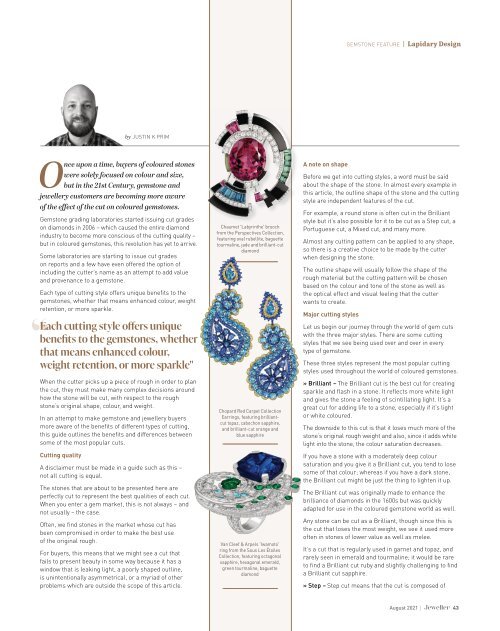You also want an ePaper? Increase the reach of your titles
YUMPU automatically turns print PDFs into web optimized ePapers that Google loves.
GEMSTONE FEATURE | Lapidary Design<br />
by JUSTIN K PRIM<br />
Once upon a time, buyers of coloured stones<br />
were solely focused on colour and size,<br />
but in the 21st Century, gemstone and<br />
jewellery customers are becoming more aware<br />
of the effect of the cut on coloured gemstones.<br />
Gemstone grading laboratories started issuing cut grades<br />
on diamonds in 2006 – which caused the entire diamond<br />
industry to become more conscious of the cutting quality –<br />
but in coloured gemstones, this revolution has yet to arrive.<br />
Some laboratories are starting to issue cut grades<br />
on reports and a few have even offered the option of<br />
including the cutter’s name as an attempt to add value<br />
and provenance to a gemstone.<br />
Each type of cutting style offers unique benefits to the<br />
gemstones, whether that means enhanced colour, weight<br />
retention, or more sparkle.<br />
Each cutting style offers unique<br />
benefits to the gemstones, whether<br />
that means enhanced colour,<br />
weight retention, or more sparkle"<br />
When the cutter picks up a piece of rough in order to plan<br />
the cut, they must make many complex decisions around<br />
how the stone will be cut, with respect to the rough<br />
stone’s original shape, colour, and weight.<br />
In an attempt to make gemstone and jewellery buyers<br />
more aware of the benefits of different types of cutting,<br />
this guide outlines the benefits and differences between<br />
some of the most popular cuts.<br />
Cutting quality<br />
A disclaimer must be made in a guide such as this –<br />
not all cutting is equal.<br />
The stones that are about to be presented here are<br />
perfectly cut to represent the best qualities of each cut.<br />
When you enter a gem market, this is not always – and<br />
not usually – the case.<br />
Often, we find stones in the market whose cut has<br />
been compromised in order to make the best use<br />
of the original rough.<br />
For buyers, this means that we might see a cut that<br />
fails to present beauty in some way because it has a<br />
window that is leaking light, a poorly shaped outline,<br />
is unintentionally asymmetrical, or a myriad of other<br />
problems which are outside the scope of this article.<br />
Chaumet 'Labyrinthe' brooch<br />
from the Perspectives Collection,<br />
featuring oval rubellite, baguette<br />
tourmaline, jade and brilliant-cut<br />
diamond<br />
Chopard Red Carpet Collection<br />
Earrings, featuring brilliantcut<br />
topaz, cabochon sapphire,<br />
and brilliant-cut orange and<br />
blue sapphire<br />
Van Cleef & Arpels 'Iwamoto'<br />
ring from the Sous Les Étoiles<br />
Collection, featuring octagonal<br />
sapphire, hexagonal emerald,<br />
green tourmaline, baguette<br />
diamond<br />
A note on shape<br />
Before we get into cutting styles, a word must be said<br />
about the shape of the stone. In almost every example in<br />
this article, the outline shape of the stone and the cutting<br />
style are independent features of the cut.<br />
For example, a round stone is often cut in the Brilliant<br />
style but it’s also possible for it to be cut as a Step cut, a<br />
Portuguese cut, a Mixed cut, and many more.<br />
Almost any cutting pattern can be applied to any shape,<br />
so there is a creative choice to be made by the cutter<br />
when designing the stone.<br />
The outline shape will usually follow the shape of the<br />
rough material but the cutting pattern will be chosen<br />
based on the colour and tone of the stone as well as<br />
the optical effect and visual feeling that the cutter<br />
wants to create.<br />
Major cutting styles<br />
Let us begin our journey through the world of gem cuts<br />
with the three major styles. There are some cutting<br />
styles that we see being used over and over in every<br />
type of gemstone.<br />
These three styles represent the most popular cutting<br />
styles used throughout the world of coloured gemstones.<br />
» Brilliant – The Brilliant cut is the best cut for creating<br />
sparkle and flash in a stone. It reflects more white light<br />
and gives the stone a feeling of scintillating light. It’s a<br />
great cut for adding life to a stone, especially if it’s light<br />
or white coloured.<br />
The downside to this cut is that it loses much more of the<br />
stone’s original rough weight and also, since it adds white<br />
light into the stone, the colour saturation decreases.<br />
If you have a stone with a moderately deep colour<br />
saturation and you give it a Brilliant cut, you tend to lose<br />
some of that colour; whereas if you have a dark stone,<br />
the Brilliant cut might be just the thing to lighten it up.<br />
The Brilliant cut was originally made to enhance the<br />
brilliance of diamonds in the 1600s but was quickly<br />
adapted for use in the coloured gemstone world as well.<br />
Any stone can be cut as a Brilliant, though since this is<br />
the cut that loses the most weight, we see it used more<br />
often in stones of lower value as well as melee.<br />
It’s a cut that is regularly used in garnet and topaz, and<br />
rarely seen in emerald and tourmaline; it would be rare<br />
to find a Brilliant cut ruby and slightly challenging to find<br />
a Brilliant cut sapphire.<br />
» Step – Step cut means that the cut is composed of<br />
<strong>August</strong> <strong>2021</strong> | 43


















